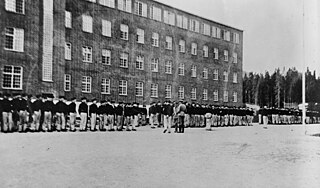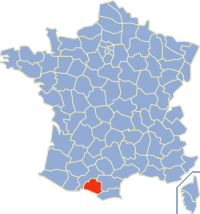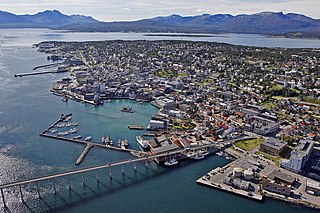
Buchenwald was a Nazi concentration camp established on Ettersberg hill near Weimar, Germany, in July 1937. It was one of the first and the largest of the concentration camps within Germany's 1937 borders. Many actual or suspected communists were among the first internees.

Reidsville is a city in Tattnall County, Georgia, United States. The population was 2,594 at the 2010 census. The city is the county seat of Tattnall County. The Georgia State Prison is near Reidsville.

Atlanta is a village in Phelps County, Nebraska, in the United States. The population was 131 at the 2010 Census. During World War II the town was neighbored by Camp Atlanta, which housed more than 3,000 Nazi German prisoners of war over three years. The camp was said to house more prisoners during the war than the town had in its entire existence.

Natzweiler-Struthof was a German-run concentration camp located in the Vosges Mountains close to the Alsatian village of Natzwiller in France, and the town of Schirmeck, about 50 km (31 m) south west of the city of Strasbourg. Natzweiler-Struthof was the only concentration camp established by the Nazis on French territory, though there were French-run temporary camps such as the one at Drancy. Between 1941 and 1944, Alsace was administered by Germany as an integral part of the German Reich. The camp operated from 21 May 1941 and was evacuated early September 1944. Only a small staff of Nazi SS personnel remained until the camp was liberated by the French First Army under the command of the U.S. Sixth Army Group on 23 November 1944.

Houlton is a town in Aroostook County, Maine, on the Canada–US border, located at 46.1256°N 67.8398°W. As of the 2010 census, the town population was 6,123. It is perhaps best known as being at the northern terminus of Interstate 95 and for being the birthplace of Samantha Smith, a goodwill ambassador as a child during the Cold War. The town hosts the annual Houlton Agricultural Fair.

The Mauthausen–Gusen concentration camp complex consisted of the Mauthausen concentration camp on a hill above the market town of Mauthausen plus a group of nearly 100 further subcamps located throughout Austria and southern Germany. The three Gusen concentration camps in and around the village of St Georgen/Gusen, just a few kilometres from Mauthausen, held a significant proportion of prisoners within the camp complex, at times exceeding the number of prisoners at the Mauthausen main camp.

Tuchola is a town in the Kuyavian-Pomeranian Voivodeship in northern Poland. The Pomeranian town, which is the seat of Tuchola County, had a population of 13,418 as of 2013.

Nazi Germany maintained concentration camps throughout the territories it controlled before and during the Second World War. The first Nazi camps were erected in Germany in March 1933 immediately after Hitler became Chancellor and his Nazi Party was given control of the police by Reich Interior Minister Wilhelm Frick and Prussian Acting Interior Minister Hermann Göring. Used to hold and torture political opponents and union organizers, the camps initially held around 45,000 prisoners. In 1933–1939, before the onset of war, most prisoners consisted of German Communists, Socialists, Social Democrats, Roma, Jehovah's Witnesses, homosexuals, and persons accused of 'asocial' or socially 'deviant' behavior by the Germans.

Sachsenhausen or Sachsenhausen-Oranienburg was a Nazi concentration camp in Oranienburg, Germany, used primarily for political prisoners from 1936 to the end of the Third Reich in May 1945. After World War II, when Oranienburg was in the Soviet Occupation Zone, the structure was used as an NKVD special camp until 1950. The camp ground with the remaining buildings is now open to the public as a museum.

Grini prison camp was a Nazi concentration camp in Bærum, Norway, which operated between 1941 and May 1945. Ila Detention and Security Prison is now located here.

Falstad concentration camp was situated in the village of Ekne in what was the municipality of Skogn in Norway. It was used mostly for political prisoners from Nazi-occupied territories.
The Bardufoss concentration camp was located in Northern Norway in the municipality of Målselv. During the occupation of Norway by Nazi Germany, the Nazi authorities established a "concentration camp in the town of Bardufoss," as an annex to the Grini concentration camp. It opened in March 1944 to alleviate overflowing in other camps, particularly Grini and the Falstad concentration camp. Situated in a cold climate, it was notorious for its hard work regime, sparse rations, and inadequate shelter. It is estimated that some 800 prisoners passed through the camp, and when liberated about 550 were incarcerated.
Espeland concentration camp was established at the village of Espeland in the borough of Arna in Bergen, Norway by the Nazi authorities of occupied Norway in the summer of 1943.

Le Vernet Internment Camp, or Camp Vernet, was a concentration camp in Le Vernet, Ariège, near Pamiers, in the French Pyrenees. In the Second World War, starting in 1940, the Vichy government used it to house prisoners considered suspect or dangerous to the government. From 1942 until June 1944, it was used as a holding camp for Jewish families awaiting deportation to other camps. The last transport out of the camp in June 1944 took the prisoners to Dachau concentration camp.

Heistadmoen is a Norwegian military encampment in Kongsberg, in the county of Buskerud, Norway. Heistadmoen currently provides able quarters for the Telemark and Buskerud Home Guard District. The camp is large and modern, most of the buildings have been recently refurbished. The camp is also used by other departments for training and shooting.

Bredtveit Prison is a prison located in the neighborhood of Bredtvet in Oslo, Norway. During World War II it was a concentration camp.

In World War II, Nazi Germany established brothels in the concentration camps (Lagerbordell) to create an incentive for prisoners to collaborate, although these institutions were used mostly by Kapos, "prisoner functionaries" and the criminal element, because regular inmates, penniless and emaciated, were usually too debilitated and wary of exposure to Schutzstaffel (SS) schemes. In the end, the camp brothels did not produce any noticeable increase in the prisoners' work productivity levels, but instead, created a market for coupons among the camp VIPs.

Death marches refers to the forcible movements of prisoners of Nazi Germany between Nazi camps during World War II. They occurred at various points during the Holocaust, including 1939 in the Lublin province of Poland, in 1942 in Reichskommissariat Ukraine and across the General Government, and between Autumn 1944 and late April 1945 near the Soviet front, from the Nazi concentration camps and prisoner of war camps situated in the new Reichsgaue, to camps inside Germany proper, away from reach of the Allied forces. The purpose was to remove evidence of crimes against humanity committed inside the camps and to prevent the liberation of German-held prisoners of war.

Ila prison and detention center is a high security prison in Ila in Bærum municipality in Akershus county, outside the capital city of Oslo in Norway. It is the national preventive detention facility for men in Norway, i.e. the prison for men serving preventive detention (forvaring), Norway's maximum penalty. Ila generally houses the most dangerous criminals in Norway, who are convicted of violent and sexual crimes.



















